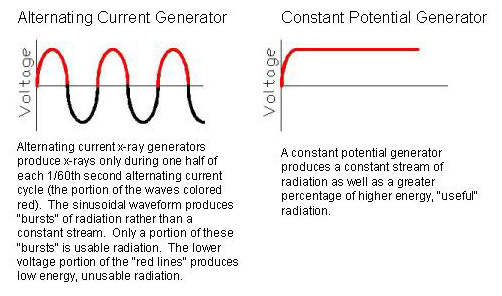Why You Need A DC X Ray Machine?
Do you use an AC X-ray Machine?
If the answer to that question is yes, then we’re glad you’re reading this article.
Using an AC X-ray machine could probably be the cheapest way to produce X-rays, which uses the alternating current from the electricity provider to power the X-ray tube head. This alternating current changes its direction about 50 times/second in the wires. Moreover, the intensity increases and decreases about 120 times/second as well. The effect of using this current is to produce X-rays that turn on and off sixty times each second. Further, the X-rays that are produced, each begin too weak to use and grow to proper strength before they decrease again to being too weak. The design of the AC X-ray requires filters of aluminium to eliminate the rays that are too weak to use.
With an alternating current generator, voltage across the tube goes from zero up to the maximum kVp, then back to zero. This produces X-ray photons of varying energies. The lowest energy photons are filtered out, but the average photon energy produced by an alternating current tube for a given kVp is still lower than the average photon energy produced by a constant potential tube at that same kV. Lower energy photons are more readily absorbed by the patient, so the more homogeneous beam of higher energy photons produced by constant potential units will reduce patient exposure. When using conventional film, the lower average photon energy of an alternating current unit will produce films of higher contrast than will a constant potential unit (for a given kVp). However, constant potential units typically operate at 60 or 65 kV compared to the 70 kVp of an alternating unit which brings the contrast levels closer to each other. While most X-ray units operate at a single, fixed kVp, some models offer the user a choice of kVp settings.
A DC X-ray machine uses direct electric current to power the X-ray tube head. These constant potential (DC) machines, neither change direction nor the intensity making it a steady supply of power. This facilitates production of smooth and consistent X-rays.
Another consideration occurs at very low exposure times used in digital radiography. AC units may not provide exposures as consistent as constant potential units at these very short exposure times. This property can be illustrated using an example exposure time of 0.04 seconds (which is a very low setting). As stated above, alternating current produces a sinusoidal waveform and X-rays are generated only in the “positive” portion of the waves. A 0.04 second exposure time would cover two and one half 1/60th second alternating current waveforms. Depending on at what point in the waveform the exposure was initiated, as few as two or as many as three “usable” portions of the waves would be captured (at least some, and perhaps all AC units have no control over which segment of the waveform an exposure is initiated). At these very low exposure settings, this could result in a 1/3 difference in exposure for the same 0.04 second timer setting (see diagram below).
In conclusion, you will experience the following benefits when switching to a DC X-ray unit:
- Consistent Images
- Lower Exposure to Radiation
- Constant kV Values even with fluctuating mains
If you wish to get more details about one of the Safest DC X-Ray Units in India, Click Here.


